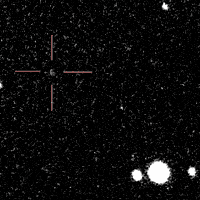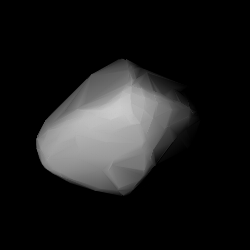Related Research Articles
1955 McMath, provisional designation 1963 SR, is a stony Koronis asteroid from the outer region of the asteroid belt, approximately 10 kilometers in diameter.
6433 Enya, provisional designation 1978 WC, is a stony background asteroid from the inner regions of the asteroid belt, approximately 7 kilometers in diameter. It was discovered on 18 November 1978, by Czech astronomer Antonín Mrkos at the Kleť Observatory in the Czech Republic. It was named for Irish musician Enya.

7167 Laupheim, provisional designation 1985 TD3, is a dark background asteroid from the outer regions of the asteroid belt, approximately 20 kilometers (12 miles) in diameter. It was discovered on 12 October 1985, by American astronomers Carolyn and Eugene Shoemaker at the Palomar Observatory in California. The presumed C-type asteroid has a rotation period of 7.04 hours and was named for Robert Clausen and his team at the public Laupheim Observatory in Germany.

9994 Grotius, provisional designation 4028 P-L, is a stony Rafita asteroid from the middle regions of the asteroid belt, approximately 3.5 kilometers in diameter. It was discovered during the Palomar–Leiden survey in 1960, and named after Dutch jurist Hugo Grotius.

9991 Anežka, provisional designation 1997 TY7, is a carbonaceous Themistian asteroid from the outer region of the asteroid belt, approximately 10 kilometers in diameter.
6349 Acapulco, provisional designation 1995 CN1, is a dark Adeonian asteroid from the middle region of the asteroid belt, approximately 22 kilometers in diameter.
14832 Alechinsky, provisional designation 1987 QC3, is a Vestian asteroid from the inner regions of the asteroid belt, approximately 4 kilometers (2.5 miles) in diameter. It was discovered on 27 August 1987, by Belgian astronomer Eric Elst at ESO's La Silla Observatory site in northern Chile. The highly elongated asteroid has a rotation period of 8.1 hours. It was named after Belgian painter Pierre Alechinsky.
15258 Alfilipenko, provisional designation 1990 RN17, is a carbonaceous background asteroid from the outer region of the asteroid belt, approximately 12 kilometers in diameter. It was discovered on 15 September 1990, by Russian–Ukraininan astronomer Lyudmila Zhuravleva at the Crimean Astrophysical Observatory, Nauchnyj, on the Crimean peninsula. The asteroid was named after Russian civil engineer Aleksandr Filipenko.
11277 Ballard (provisional designation 1988 TW2) is a Phocaea asteroid from the inner regions of the asteroid belt, approximately 6.3 kilometers (3.9 miles) in diameter. It was discovered on 8 October 1988, by American astronomer couple Carolyn and Eugene Shoemaker at the Palomar Observatory in California. The assumed S-type asteroid has a rotation period of at least 10 hours. It was named for American marine scientist Robert Ballard.
3996 Fugaku, provisional designation 1988 XG1, is a stony Florian asteroid from the inner regions of the asteroid belt, approximately 5.5 kilometers in diameter. It was discovered on 5 December 1988, by Japanese amateur astronomers Masaru Arai and Hiroshi Mori at Yorii Observatory in central Japan. It was named for Mount Fuji, Japan.
14789 GAISh, provisional designation 1969 TY1, is a dark background asteroid from the outer regions of the asteroid belt, approximately 15 kilometers (9 miles) in diameter. It was discovered on 8 October 1969, by Soviet astronomer Lyudmila Chernykh of the Crimean Astrophysical Observatory at Nauchnij, on the Crimean peninsula. The assumed C-type asteroid has a rotation period of 8.1 hours and possibly an elongated shape. It was named for the Russian Sternberg Astronomical Institute (GAISh) of Moscow State University.
2054 Gawain, provisional designation 4097 P-L, is a dark and elongated asteroid from the outer regions of the asteroid belt, approximately 19 kilometers in diameter. Discovered during the Palomar–Leiden survey at Palomar Observatory in 1960, the asteroid was later named after Gawain, a knight of King Arthur's Round Table in the Arthurian legend.
5385 Kamenka, provisional designation 1975 TS3, is a background asteroid from the outer regions of the asteroid belt, approximately 16 kilometers (10 miles) in diameter. It was discovered on 3 October 1975, by Soviet astronomer Lyudmila Chernykh at the Crimean Astrophysical Observatory in Nauchnij, on the Crimean peninsula. The presumed C-type asteroid has a rotation period of 6.68 hours. It was named for the Ukrainian town of Kamianka.
4944 Kozlovskij, provisional designation 1987 RP3, is a carbonaceous Witt asteroid from the central regions of the asteroid belt, approximately 10 kilometers (6 miles) in diameter. It was discovered on 2 September 1987, by Soviet astronomer Lyudmila Chernykh at the Crimean Astrophysical Observatory in Nauchnij, on the Crimean Peninsula. The asteroid was named for Russian opera singer Ivan Kozlovsky.
4789 Sprattia, provisional designation 1987 UU2, is a stony background asteroid from the inner regions of the asteroid belt, approximately 4 kilometers (2.5 miles) in diameter. It was discovered on 20 October 1987, by Canadian astronomer David Balam at the Climenhaga Observatory (657) in Victoria, Canada. The S-type asteroid has a rotation period of 3.1 hours and was named after Canadian amateur astronomer Christopher E. Spratt.
17163 Vasifedoseev (provisional designation 1999 LT19) is a stony Koronian asteroid from the outer region of the asteroid belt, approximately 4 kilometers in diameter.
1778 Alfvén, also designated 4506 P-L, is a carbonaceous Themistian asteroid from the outer region of the asteroid belt, approximately 20 kilometers in diameter.

1422 Strömgrenia, provisional designation 1936 QF, is a stony Florian asteroid from the inner regions of the asteroid belt, approximately 5.5 kilometers in diameter. It was discovered on 23 August 1936, by German astronomer Karl Reinmuth at Heidelberg Observatory in southern Germany, and named after Swedish-Danish astronomer Svante Elis Strömgren.
12564 Ikeller, provisional designation 1998 SO49, is a stony Koronian asteroid from the outer region of the asteroid belt, approximately 5 kilometers in diameter.
32226 Vikulgupta (provisional designation 2000 OQ23) is a stony Flora asteroid from the inner regions of the asteroid belt, approximately 3.5 kilometers in diameter.
References
- 1 2 3 4 "JPL Small-Body Database Browser: 6102 Visby (1993 FQ25)" (2017-02-11 last obs.). Jet Propulsion Laboratory . Retrieved 21 June 2017.
- 1 2 3 Schmadel, Lutz D. (2007). "(6102) Visby". Dictionary of Minor Planet Names – (6102) Visby. Springer Berlin Heidelberg. p. 509. doi:10.1007/978-3-540-29925-7_5647. ISBN 978-3-540-00238-3.
- 1 2 3 4 Mainzer, A.; Grav, T.; Masiero, J.; Hand, E.; Bauer, J.; Tholen, D.; et al. (November 2011). "NEOWISE Studies of Spectrophotometrically Classified Asteroids: Preliminary Results". The Astrophysical Journal. 741 (2): 25. arXiv: 1109.6407 . Bibcode:2011ApJ...741...90M. doi:10.1088/0004-637X/741/2/90.
- 1 2 3 Masiero, Joseph R.; Mainzer, A. K.; Grav, T.; Bauer, J. M.; Cutri, R. M.; Dailey, J.; et al. (November 2011). "Main Belt Asteroids with WISE/NEOWISE. I. Preliminary Albedos and Diameters". The Astrophysical Journal. 741 (2): 20. arXiv: 1109.4096 . Bibcode:2011ApJ...741...68M. doi:10.1088/0004-637X/741/2/68 . Retrieved 5 December 2016.
- 1 2 3 4 5 "LCDB Data for (6102) Visby". Asteroid Lightcurve Database (LCDB). Retrieved 14 July 2016.
- 1 2 3 Chang, Chan-Kao; Ip, Wing-Huen; Lin, Hsing-Wen; Cheng, Yu-Chi; Ngeow, Chow-Choong; Yang, Ting-Chang; et al. (June 2014). "313 New Asteroid Rotation Periods from Palomar Transient Factory Observations". The Astrophysical Journal. 788 (1): 21. arXiv: 1405.1144 . Bibcode:2014ApJ...788...17C. doi:10.1088/0004-637X/788/1/17 . Retrieved 14 July 2016.
- 1 2 Veres, Peter; Jedicke, Robert; Fitzsimmons, Alan; Denneau, Larry; Granvik, Mikael; Bolin, Bryce; et al. (November 2015). "Absolute magnitudes and slope parameters for 250,000 asteroids observed by Pan-STARRS PS1 - Preliminary results". Icarus. 261: 34–47. arXiv: 1506.00762 . Bibcode:2015Icar..261...34V. doi:10.1016/j.icarus.2015.08.007 . Retrieved 14 July 2016.
- 1 2 "6102 Visby (1993 FQ25)". Minor Planet Center. Retrieved 14 July 2016.
- ↑ "MPC/MPO/MPS Archive". Minor Planet Center. Retrieved 14 July 2016.